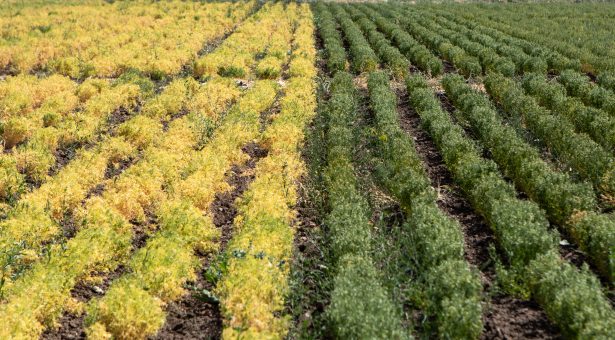United Kingdom
October 31, 2024

An international research collaboration has completed the most detailed genome assembly to date of grass pea (Lathyrus sativus).
This new chromosome-scale reference genome published in Scientific Data offers new potential to accelerate modern breeding of this underutilised legume for climate-smart agriculture.
Nearly twice the size of the human genome, the sequence was assembled from scratch and improves on an earlier draft assembly of the vigorous grass pea line LS007.
“We want to establish this new genome sequence as the reference genome for the grass pea community, and we’re delighted to share this valuable resource for other scientists to use and learn about grass pea,” explained corresponding author of the research Dr Peter Emmrich, a researcher at Norwich Institute for Sustainable Development (NISD) and visiting group leader at the John Innes Centre.
“At a time of increasing weather shocks, this genome allows us to unlock the secrets of grass pea’s resilience, to further improve this crop for farmers, and inform development of other crops, such as peas,” he added.
Improvements in genome accuracy and completeness also allow researchers to study evolutionary links between species, helping identify gene pathways that could be used to improve the crop or to understand its remarkable drought tolerance.
Dr Anne Edwards, research assistant at the John Innes Centre, said: “As we prepare for a future of increased climate change, we are going to need crops that can cope with drought, or flooding or inundations of salt water. This new genome sequence means that we are even closer to adding grass pea to the list of climate-smart crops of tomorrow. It’s an exciting time to be in the grass pea research community!”
What is Grass Pea?
Grass pea is a crop grown in many regions of the world that is high in protein and resilient to drought and flooding. One of the oldest known cultivated plants, grass pea is now grown in Ethiopia, Eritrea, India, Bangladesh, and Nepal. It has been used for centuries as an insurance crop, that survives when other crops fail and is safe to eat as part of a balanced diet.
Grass pea is among a group neglected and underutilised crops that play a key role in local nutrition and livelihoods, but that historically have received little attention from breeders and researchers. However, its resilience to both drought and flooding makes it a promising crop for ensuring food security in a changing climate.
Grass pea’s widespread cultivation has been hampered due to a toxin contained within its seeds and shoots, which can, in malnourished people, cause the disease neurolathyrism, a condition which causes irreversible paralysis. Another major barrier preventing crop breeding improvements was the lack of a genome reference for the crop.
The availability of the new genome sequence means researchers could use gene editing and modern breeding methods to develop varieties of grass pea with improved agronomic characteristics or low or zero toxin content. This means that grass pea could be poised to make an important contribution to a more diversified and climate resilient food system in the future.
Image credit: Matt Heaton. Photo taken at the Marchouch Field Station in Morocco, showing grass pea (right) next to a lentil crop (left) planted at the same time, suffering from lack of water.